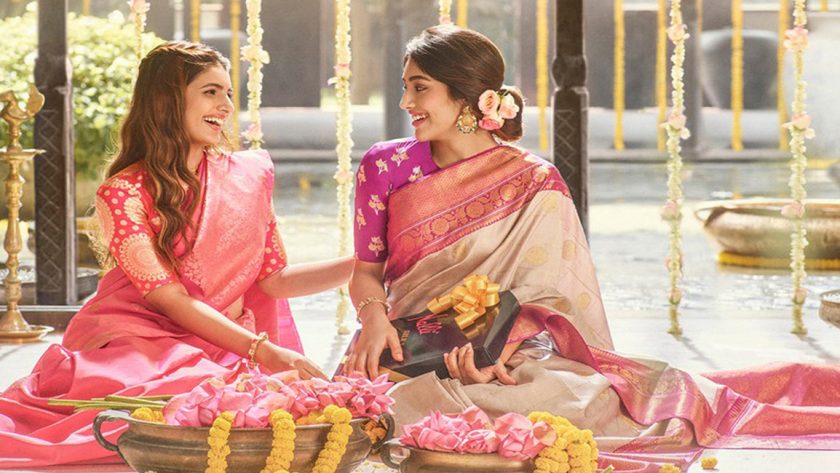I put on my first sari in the dim light of a Bangalore hotel room, in India. Unfastening all of my cut-and-sewn American clothes, I stepped into a plain beige cotton petticoat and tied the drawstring at my waist. The petticoat came to my toes and rustled in the breeze from the overhead fan, my only relief from the damp heat of southern India. I put on the cropped, short-sleeved cotton blouse. Then I carefully unfolded the paisley-printed fabric, trying not to drag it on the floor. I was half-dressed and sweating already, and the breeze from the fan kept picking up the sixteen feet of light silk and blowing it out of my control. Donning a sari was going to be more difficult than I had thought.
The sari is as synonymous with India as the kimono is with Japan, and with good reason. Few cultures can boast that they have maintained a fashion style for thousands of years, but saris have been a part of Hindu society since prehistoric times. You might find a Chinese peasant wearing Nikes, but in the streets of Calcutta and Delhi the sari-the antithesis of the little black dress-is the thing.
Despite my own devotion to monochromatic, tailored shifts, I longed for a sari (properly pronounced a little long on the “a” and with an affectionate roll of the “r”) for years. Maybe I sensed the truth: that the little “sari” dresses and bags I saw at home were just faint tastes of the beautiful draped clothing of India. So when a friend’s Indian wedding coincided with my first visit to the country, I decided it was the perfect opportunity to indulge in one or two or ten.
In Mumbai, I went to a reputable (and expensive) sari shop, where saris lined the walls and racks. All I could do at first was stare and touch all these gorgeous fabrics. I glanced at price tags, but was so overwhelmed I was unable to calculate the costs. There were saris in everything from the heaviest brocade silks to the lightest cottons. They had gold borders, flowered embroidery, bead work, every kind of print and weave I could ever imagine; each one was more beautiful, colorful, and elaborate than anything I had seen, certainly anything I had ever worn in the States. Women sat on low padded stools in front of glass counters. Behind the counters were shelves packed with hundreds, if not thousands, of folded lengths. Of each, only an edge, a slash of color was visible.
When I awoke from my reverie, I realized how far out of my price range many of the pieces were. But there, in the corner, was a small rack marked “defective saris.” Defective? To my eyes, they were perfect. I chose a ruby-red silk sari woven with silver-colored threads.
“You need measurements,” a woman said. Wait-wasn’t this a one-size fits-all garment?
Yes and no, I discovered. The standard sari is an oblong of fabric about sixteen feet long, with borders on the edges and 20 inches of decoration called the pallu on one end. The pallu can consist of something as simple as a few stripes, or be intricately woven, embroidered, or worked with mirrors.
Saris can be wrapped around the body in an infinite number of ways. Traditionally, the fabric and drape of a sari indicated a woman’s marital status, religion, ethnicity, regional origin, and caste. With the caste system becoming less binding, many women wear their saris in the modern “nivi” style. But while the move towards egalitarianism is positive, it may also result in the disappearance of dozens of sari drapes. After all, each garment is fleeting, a work of art whose form is lost as soon as it is untied.
After that first purchase in Mumbai, I was unable to stop. I bought a pink cotton one woven with gold, a violet one, a white sari with green stitching, and a silk one with a brown-and-white paisley pattern.
In the Jaipur bazaar, I was taken into a back room, where I sat on a large cushion covered in white cotton, and was shown saris to my heart’s content. The proprietor flipped each one open with a flourish, describing the lengths. This is the pallu. This is all embroidered. This pattern is woven, not printed. This one very beautiful.
I was so busy looking and buying that I never bothered to learn how to wear any of my saris. Then I was alone in Bangalore, with only an illustrated instructional pamphlet. I wrapped and tucked as the pictured showed. I pleated a yard of fabric between my fingers, dropping the folds again and again until finally I managed stuff the top of the bunch into my waistband. Then I drew the free end around again and triumphantly threw the pallu over my left shoulder, letting it fall down one side of my back. Patting my forehead with a towel, I looked in the mirror, pleased with the results.
I made my way down the stairs, pleats catching between my legs, hitching the pallu up onto my shoulder. The plump woman at the front desk did a double-take. She beckoned with a finger and leaned over the counter to whisper, “I can not let you go outside like that. Everyone will laugh at you.” I was utterly deflated.
She ushered me back to my room and unwrapped what I thought was my neat little package of a sari. She clucked at my ill-fitting blouse, unhooked a few hooks, tugged the bottom corners together, and tied them so tightly against my ribs I could barely breathe. She made a knot in the starting end of my sari, then anchored it back into my waistband. She wrapped me, and then deftly pleated the silk into perfectly even folds, tucking the smooth slab of fabric in and pinning it with a safety pin she took from her own clothes. Then she pleated the loose end, pinned it to my shoulder, and smoothed the folds so the pallu draped beautifully down my back.
“There,” she said with a satisfied smile. “That’s better.”
It was better. I felt gently cocooned, secure but not stifled. I stood straight (it is almost impossible to slouch in a sari), the fabric moved with me, and when I sat, the silk piled around me in fresh mounds. I felt graceful and light as I made my way to the street.
Back home, I have pondered other uses for my saris. I finger the borders, unfold them, wrap them around my waist, show them off to friends. I can’t bear to cut them up for mundane things like pillows, lampshades, or tank tops. I pack them up and put them away like good jewelry, the things that are too beautiful to wear in real life.



